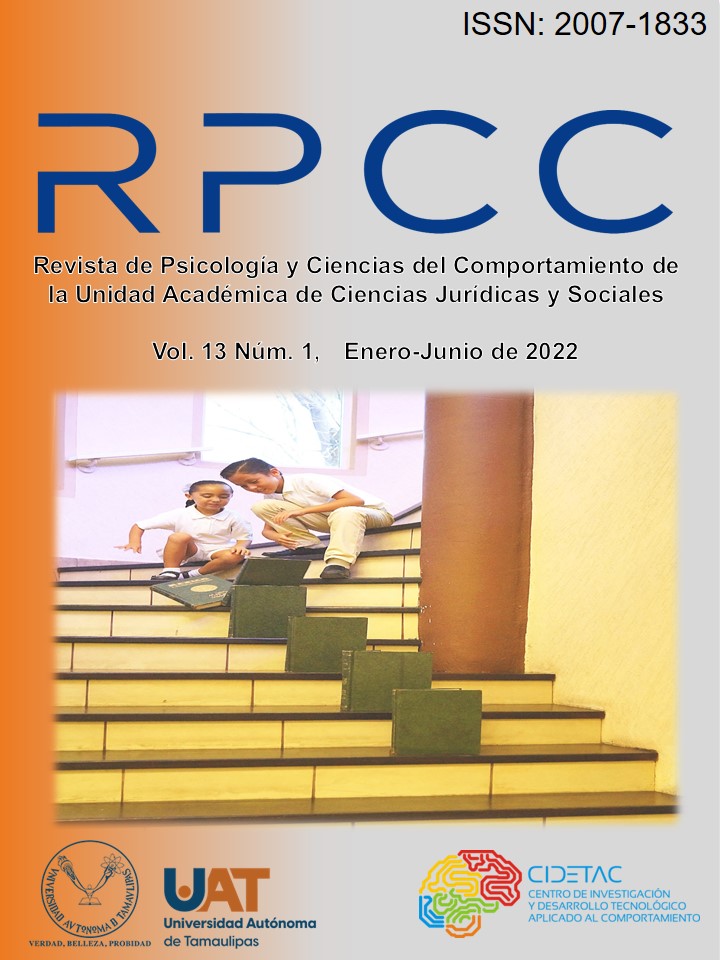Escala Escuelas Saludables y Resilientes: Evidencias Argentinas de Validez de Constructo, Estructura Interna y Confiabilidad
DOI:
https://doi.org/10.29059/rpcc.20220501-140References
Acosta, H., Cruz-Ortiz, V., Salanova, M. & Llorens, S. (2015). Healthy organization: Analyzing its meaning based on the HERO Model. International Journal of Social Psychology, 30, 323-350. http://dx.doi.org/10.1080/21711976.2015.1016751 DOI: https://doi.org/10.1080/21711976.2015.1016751
Benítez-Saña, R. M. (2021). Sistemas de trabajo de alto rendimiento y modelo de organización saludable frente al impacto psicológico de la COVID-19 en profesionales sanitarios. Estudios Gerenciales, 37(159), 167-177. https://doi.org/10.18046/j.estger.2021.159.4376 DOI: https://doi.org/10.18046/j.estger.2021.159.4376
Hair, J. E., Black, W. C., Babin, B. J., Anderson, R. E., & Tatham, R. L. (2019). Multivariate data analysis. Hampshire, UK: Cengage Learning, EMEA.
Hurtado Mondoñedo, L. (2018). Relación entre los índices de dificultad y discriminación. Revista Digital de Investigación en Docencia Universitaria, 12(1), 273-300. http://dx.doi.org/10.19083/ridu.12.614 DOI: https://doi.org/10.19083/ridu.12.614
Izquierdo, I., Olea, J., & Abad, F. (2014). Exploratory factor analysis in validation studies: Uses and recommendations. Psicothema, 26(3), 395-400. http://dx.doi.org/10.7334/psicothema2013.349 DOI: https://doi.org/10.7334/psicothema2013.349
Luthans, F., & Youssef-Morgan, C. M. (2017). Psychological capital: An evidence-based positive approach. Annual Review of Organizational Psychology and Organizational Behavior, 4, 339-366. https://doi.org/10.1146/annurev-orgpsych-032516-113324 DOI: https://doi.org/10.1146/annurev-orgpsych-032516-113324
Lloret, S. Ferreres, A., Hernández, A. & Tomás, I. (2017). El análisis factorial exploratorio de los ítems: análisis guiado según los datos empíricos y el software. Anales de Psicología, 33(2), 1695-2294. https://dx.doi.org/10.6018/analesps.33.2.270211 DOI: https://doi.org/10.6018/analesps.33.2.270211
Mangan, S., Baumsteiger, R., & Cotton-Bronck, K. (2020). Recommendations for positive psychology interventions in school settings. The Journal of Positive Psychology 15(4), 1-4. https://dx.doi.org/10.1080/17439760.2020.1789709 DOI: https://doi.org/10.1080/17439760.2020.1789709
Olvera, J., Llorens, S., Acosta, H., & Salanova, M. (2017). Transformational leadership and horizontal trust as antecedents of team performance in the healthcare context. Anales de Psicología, 33(2), 365-375 http://dx.doi.org/10.6018/analesps.33.2.237291 DOI: https://doi.org/10.6018/analesps.33.2.237291
Omar, A. (2005). La cultura organizacional de las empresas argentinas. Rosario, Argentina: Conicet.
Omar, A., Salessi, S. & Urteaga, F. (2017). Impact of management practices on job satisfaction. Revista de Administração Mackenzie 18(5), 92-115. https://doi.org/10.1590/1678-69712017/administracao.v18n5p92-115 DOI: https://doi.org/10.1590/1678-69712017/administracao.v18n5p92-115
Omar, A., Salessi, S. & Urteaga, F. (2014). Diseño y validación de una nueva escala para medir capital psicológico. Liberabit, 20(2), 315-323.
Plaza Leutar, M. (2021). Positive psychology: From its origins to school practice in relation with pedagogy and logotherapy. Acta Iadertina, 18(2). https://doi.org/10.15291/ai.3608 DOI: https://doi.org/10.15291/ai.3608
Reyes-Reyes, F., Reyes-Reyes, A., & Díaz-Narváez, V. (2019). Acerca de los sistemas de clasificación de diseños de investigación en psicología: importancia y alcance. Interciencia: Revista de Ciencia y Tecnología de América, 44(5), 303-309
Salanova, M., Llorens, S., Cifre, E. & Martínez, I. M. (2012). We need a HERO! Towards a validation of the Healthy & Resilient Organization (HERO) Model. Group & Organization Management, 37, 785-822. DOI: https://doi.org/10.1177/1059601112470405
Salanova, M., Llorens, S. & Martínez, I. (2016). Aportaciones desde la psicología organizacional positiva para desarrollar organizaciones saludables y resilientes. Papeles del Psicólogo, 37(3), 177-184.
Salanova, M., Acosta-Antognoni, H., Llorens, S. & Le Blanc, P. (2021). We trust you! A multilevel-multireferent model based on organizational trust to explain performance. International Journal of Environmental Research and Public Health 18, 4241. https://doi.org/10.3390/ijerph1808424 DOI: https://doi.org/10.3390/ijerph18084241
Salessi, S. (en prensa). Prácticas organizacionales positivas en tiempos de pandemia: Un estudio descriptivo con docentes santafesinos. Revista Perspectivas en Psicología.
Salessi, S. (2020). Capital psicológico, pasión por el trabajo y comportamiento innovador: un estudio exploratorio con docentes santafesinos. Revista de Psicología. http://dx.doi.org/10.24215/2422572Xe045 DOI: https://doi.org/10.24215/2422572Xe045
Salessi, S. & Omar, A. (2016). Satisfacción laboral genérica. Propiedades psicométricas de una escala para medirla. Alternativas en Psicología, 34(1), 93-108.
Salessi, S. & Omar, A. (2018). Inventario de flow en el trabajo: Evidencias de validez de la estructura interna y criterio. Avaliação Psicológica, 17(3), 378-388. http://dx.doi.org/10.15689/ap.2018.1703.14741.11 DOI: https://doi.org/10.15689/ap.2018.1703.14741.11
Salessi, S. & Omar, A. (2021). Propiedades psicométricas de la versión argentina de la escala de personalidad proactiva. Psico-USF, Bragança Paulista, 26(2); 203-214. http://dx.doi.org/10.1590/1413-82712021260201 DOI: https://doi.org/10.1590/1413-82712021260201
Tabachnick, B., Fidell, L., & Ullman, J. (2019). Using Multivariate Statistics. New York, NY: Pearson.
Ventura-León, J. & Caycho-Rodríguez, T. (2017). El coeficiente Omega: un método alternativo para la estimación de la confiabilidad. Revista Latinoamericana de Ciencias Sociales, Niñez y Juventud, 15(1), 625-627.
Vergara, G., Fraire, V., Manavella, A., & Salessi, S. (2020). Prácticas, percepciones y emociones de docentes de Argentina en tiempos de pandemia Covid-19. International Journal of Educational Research and Innovation 15, 568-584. https://doi.org/10.46661/ijeri.5903 DOI: https://doi.org/10.46661/ijeri.5903
Downloads
Published
Issue
Section
License

This work is licensed under a Creative Commons Attribution-NonCommercial-ShareAlike 4.0 International License.
Those authors who have publications with the Journal of Psychology and Behavioral Sciences of the Academic Unit of Legal and Social Sciences, accept the following terms:
a. The authors will retain their copyright and guarantee the journal the right to first publish their work, which will be simultaneously subject to the Creative Commons Attribution-NonCommercial-Share Alike 4.0 International License. which allows third parties to share the work as long as its author and his first publication are indicated this journal.
b. Authors may adopt other non-exclusive license agreements for the distribution of the version of the published work (e.g., deposit it in an institutional telematic archive or publish it in a monographic volume) provided that the initial publication in this journal is indicated.
C. Authors are allowed and recommended to disseminate their work through personal communication (e.g. colleagues) before and during the submission process, for purposes of feedback or enrichment of the work, which can produce interesting exchanges








